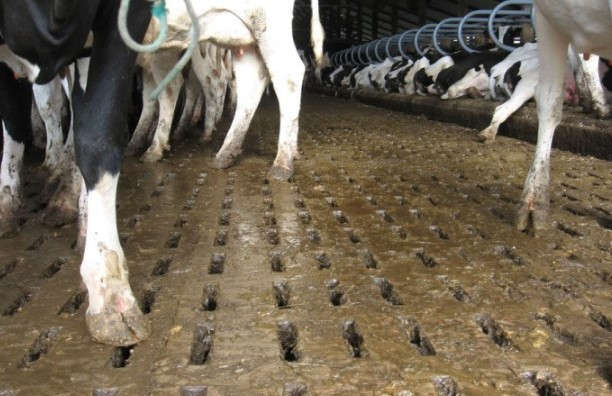By Dennis Murphy
The use of confinement systems for livestock and dairy production is a well established practice in American agriculture (see figures 1 & 2). Integral to many animal confinement systems is automated feeding and watering of the animals, barn ventilation, and manure and waste water handling. Automated manure and waste water handling is most often accomplished by collecting and storing manure and waste in storages located directly beneath the animals or in a nearby containment structure that may be located either below ground or at ground level. In many cases, the collection system usually involves a smaller below ground pit for pumping the manure to a longer-term storage structure or for pumping the manure directly into a manure spreader. While this method of manure handling is very efficient, it can create a unique set of hazards for both humans and animals. The purpose of this publication is to identify confined space manure storage hazards and methods for reducing risks when entering storages that are empty or nearly empty.

Figure 1. Slotted floors, like this example in a dairy barn, cover a manure storage that may be up to 10 feet deep, usually referred to as deep-pit storage.
Figure 2. Slotted floors are also used extensively in swine facilities.
Manure Storages and Confined Spaces
Most below ground manure storages, above ground tanks and transfer structures (e.g., enclosed gravity flow ways to move manure between storages) meet the definition of a confined space. This means that it: 1) Is large enough and so configured that a worker can enter and perform work; (2) Has limited or restricted means for entry or exit; and (3) Is not designed for continuous human occupancy (OSHA, Confined Space Standard 1910.146). The hazards contained within a confined space manure storage may include a lack of oxygen, toxic and flammable gases, and exposure to drowning. Once a person has entered a confined space manure storage, it is often too late to mitigate the associated hazards. The human senses of smell and sight are not helpful since the gases being generated by the manure are colorless, may be odorless, and are easily masked by other common farm smells. For example, hydrogen sulfide, one of the most dangerous manure gases, has an odor but it is often not detectable above 100 parts per million (PPM) because it deadens the sense of smell. The characteristic colorless and odorless factors and undetected low oxygen levels often fool even the most experienced farmer.
Tragically, fatalities occur when workers enter facilities and are overcome by toxic manure gases or are exposed to an oxygen-deficient atmosphere. Between 1975 and 2004, 65 fatalities were reported across the U.S. when farmers, workers, family members and would-be rescuers unknowingly entered manure storages when dangerous levels of manure gas or a lack of oxygen were present (Beaver and Field, 2007). This report also showed that the rate of deaths per year in manure storages is increasing. Several of the multiple fatality incidents involved immediate family members who lived and worked on the farm. Later reports on the incidents indicated that the initial entry into the storage was to perform work in a manner that was typical on that farm.
Monitoring Gas Levels
Use of a hand-held gas detection monitor prior to and during any entry event is highly recommended. These monitors must be properly calibrated, maintained and used.
Hand-held, portable gas detection monitors are now available that not only provide a reliable digital read-out of the gas levels present but also have multiple warning alarms that activate (see figure 3). Many newer portable gas detectors have the option of measuring multiple gases, including oxygen, and can be borrowed, rented, or purchased.
Figure 3. Hand-held, portable multi-gas monitors measure most of the manure gases and oxygen levels.
Hand-held gas monitor costs generally start at about $250 for a single gas detector and range up to $1,400 for better quality multiple gas monitors. When using these detectors, it is important to periodically recalibrate them according to the owner's manual. Battery-powered units should be checked regularly to ensure they are fully charged.
Monitoring of manure gas levels can also be measured with gas detector tubes. These tubes contain a reactant that changes color based on the gases that are present and their concentration. The drawbacks for this type of gas monitoring are the delayed time in which the gas levels are displayed and the lack of an accurate measurement that can be as much as 25 percent different from the actual gas level. Manure gases, especially hydrogen sulfide, are particularly critical at higher levels and any delay in detecting or accurately measuring these dangerous levels is life-threatening. See publication Confined Space Manure Gas Monitoringfor more gas monitoring details.
Click here to see more...